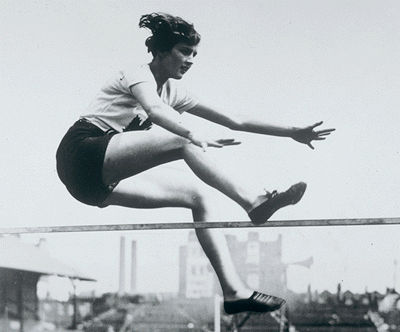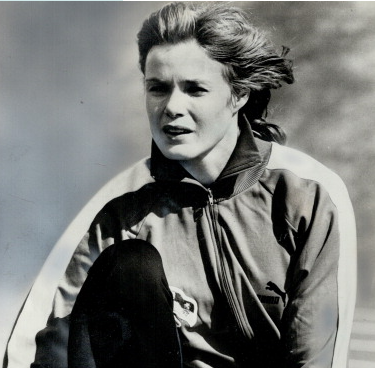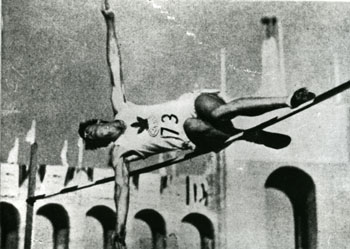This article has been updated with the generous support of Canada’s Sports Hall of Fame.
Debbie Brill, OC, track and field athlete (born 10 March 1953 in Mission, BC). An originator of the reverse jumping style, a.k.a. the “Brill bend,” Debbie Brill was an 11-time national champion who set multiple Canadian records in women’s high jump. Her record of 1.98 m, set in 1984, stands to this day. She was also the first North American woman to clear the 6-foot (1.83 m) barrier. Brill won gold at the 1970 and 1982 Commonwealth Games, the 1971 Pan American Games and the 1979 International Amateur Athletic Federation World Cup. She also set the world indoor record (1.99 m) in 1982 and set two world records as a master’s athlete. Brill co-won the Bobbie Rosenfeld Award in 1971 and was named BC's Athlete of the Decade in 1980. She has been inducted into the Canadian Olympic Hall of Fame, the BC Sports Hall of Fame, the Athletics Canada Hall of Fame and Canada’s Sports Hall of Fame.
Debbie Brill
Canadian high jumper Debbie Brill during a sports event at Crystal Palace in London, UK, 10 September 1971.
(photo by Evening Standard, courtesy Hulton Archive via Getty Images)
Early Life
Growing up in the tall forests and lush valleys of British Columbia’s lower mainland, Debbie Brill was always challenging herself to run faster and jump higher as a young athlete. Born and raised in Mission to a Canadian carpenter father and a US-born mother, Brill had athletic instincts from an early age. As she told People magazine in 1982, “When I was five, I decided to race my father because I just knew I could beat him. I cried when I lost.”
Brill was dominating the high jump in local sporting events by the time she was nine. “It suited my temperament,” she told People. “I didn’t make friends easily, so team sports were out. But when I was running and jumping, I felt I could fly.” She spent hours practicing on the family farm and was encouraged by her parents, who created homemade landing mats using fishnets and foam from a second-hand furniture store.
Technique
Debbie Brill developed a unique reverse jump technique that became known as the “Brill bend.” She would approach the bar directly from the side and fling herself backwards up and over, landing on her back. Brill developed the technique independently from American athletes Dick Fosbury and Bruce Quande, who crafted similar approaches around the same time.

Career Highlights
Debbie Brill competed internationally for the first time in 1968, at the age of 15. At the age of 16, she became the first North American woman to clear six feet in the high jump. The feat resulted in her being ranked No. 12 in the world. She also broke the Canadian record in 1969. She went on to win gold at both the 1970 Commonwealth Games and the 1971 Pan American Games. In 1971, she and pentathlete Debbie Van Kiekebelt were named co-winners of the Bobbie Rosenfeld Award as Canada’s female athlete of the year.
However, overwhelmed by the spotlight and pressure her newfound fame had brought her, Brill quit the high jump five months before the 1972 Olympic Summer Games in Munich. (“It was like the world was closing in on me,” she told People in 1982.) She rejoined Team Canada in time for the competition but finished eighth. She also spoke out against the International Olympic Committee’s decision to continue the Games after a Palestinian terrorist attack left 11 Israeli athletes dead.
Disillusioned with the sport, Brill retired from track and field and spent the next two years living a free-spirited lifestyle, hitchhiking around BC and California. During this time, she met her life partner, Greg Ray, at a bar in Maple Ridge, BC.
Brill returned to competition in 1974, winning the Canadian title that year. She competed at the 1975 Pan Am Games but finished fourth, missing the podium by 0.02 m. She was favoured to reach the podium at the Montreal Olympics in 1976, but missed all three attempts at the opening standard of 1.75 m and failed to advance past the qualifying round.
Also in 1976, Brill set a new Canadian record and began attending Simon Fraser University. She had an excellent year in 1977, winning silver at the Universiade, gold at the Pacific Conference Games and bronze at the World Cup. She also won silver at the 1978 Commonwealth Games, bronze at the 1979 Pan American Games and gold at the 1979 World Cup. Brill was ranked No. 1 in the world when Canada joined an international boycott of the 1980 Olympic Summer Games in Moscow (which Brill fully supported) to protest the Soviet invasion of Afghanistan. Brill lost the chance to compete for an Olympic medal at the height of her career.
With characteristic integrity, Brill continued to challenge limiting assumptions about women in athletics. In 1982, she cleared 1.99 m to set the world indoor high jump record, five months after giving birth to her first child. She did this at a time when there was no information or precedence about how to return to high-level competition after childbirth. The record still stands to this day. Brill also won gold at the 1982 Commonwealth Games.
Master’s Career Highlights
Retiring from competition in 1988, Debbie Brill never stopped looking for new opportunities to challenge herself. She later began taking part in master’s competitions (for retired and senior athletes) and was honoured as BC's Master Athlete of the Year in 1998. In 1999, she broke the world master’s record for athletes over 45 with a jump of 1.76 m. In 2004, she cleared 1.60 m to set a new world master’s record for athletes over 50.
Other Activities
A lifelong advocate for gender equity and inclusivity in sport, Debbie worked as an athlete representative to help successfully campaign for the removal of women’s sex testing from IAAF competition in 1992. She also served as a member of the Board of Directors for the BC Games Society, drawing on her experience to support aspiring young athletes in her home province.
Brill’s memoir, Jump, which she co-wrote with James Lawton, was published in 1986.
Legacy
Debbie Brill won a combined total of 65 national and international championships. She has held the Canadian record in women’s high jump since 1976 and set the current record of 1.98 m in 1984. She was also a bold innovator and a trailblazer in her sport. Along with similar approaches developed independently and concurrently by American athletes Dick Fosbury and Bruce Quande, Brill redefined what athletes could achieve in the high jump. She also redefined what women are capable of accomplishing in sport.
International Record
|
Year |
Competition |
Result |
Height |
|
1969 |
Pacific Conference Games |
Gold |
1.71 m |
|
1970 |
Commonwealth Games |
Gold |
1.78 m |
|
1971 |
Pan American Games |
Gold |
1.85 m |
|
1972 |
Olympic Summer Games |
8th |
1.82 m |
|
1975 |
Pan American Games |
4th |
1.81 m |
|
1976 |
Olympic Summer Games |
Did not advance past qualifying round |
N/A |
|
1977 |
Universiade |
Silver |
1.90 m |
|
1977 |
Pacific Conference Games |
Gold |
1.88 m |
|
1977 |
World Cup |
Bronze |
1.89 m |
|
1978 |
Commonwealth Games |
Silver |
1.90 m |
|
1979 |
Pan American Games |
Bronze |
1.85 m |
|
1979 |
World Cup |
Gold |
1.96 m |
|
1982 |
Commonwealth Games |
Gold |
1.88 m |
|
1983 |
World Championships |
6th |
1.88 m |
|
1984 |
Olympic Summer Games |
5th |
1.94 m |
|
1985 |
World Indoor Games |
Bronze |
1.90 m |
|
1986 |
Commonwealth Games |
5th |
1.88 m |
Honours and Awards
- Bobbie Rosenfeld Award (1971)
- British Columbia's Athlete of the Decade (1980)
- Inductee, Canadian Olympic Hall of Fame (1982)
- Officer, Order of Canada (1983)
- Inductee, Simon Fraser University Hall of Fame (1986)
- Inductee, BC Sports Hall of Fame (1989)
- Inductee, Burnaby Sports Hall of Fame (2004)
- Inductee, Athletics Canada Hall of Fame (2011)
- Queen Elizabeth II Diamond Jubilee Medal (2012)
- Inductee, Canadian Masters Hall of Fame (2016)
- Order of Sport, Canada’s Sports Hall of Fame (2024)

 Share on Facebook
Share on Facebook Share on X
Share on X Share by Email
Share by Email Share on Google Classroom
Share on Google Classroom



